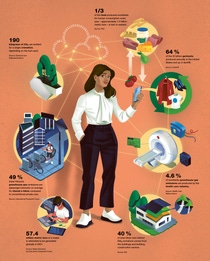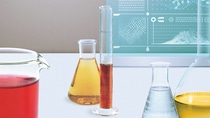Life in a cycle
In Hannah’s world, people’s needs and wants are met almost entirely through solutions that are part of the circular economy. Her world is the future we are striving for, and many of these concepts are already being implemented today and continue to be developed.
Click on the plus sign to learn more about the concepts that already play a major role in the present.
Hover over the elements to learn more about the concepts that are already relevant today.

Clothing: Reuse
Second-hand is increasingly fashionable. New platforms connect buyers with sellers, keeping clothing in use and out of landfill for longer.
thredUP, based in Oakland, United States, is one of several recommerce platforms aiming to meet this demand at scale with smart algorithms to determine prices. It can process some 111,000 items a day.
End of life: Recycling
What about the end of our own life? The wood and cement used for burial and the energy for cremation have a substantial environmental impact.
Recompose in Seattle, United States, has developed a process using naturally occurring beneficial microbes that break down the body in weeks. The resulting nutrient-dense soil can be used to enrich forests or gardens.
Digitalization – backbone of the circular economy
Digital technologies drive the circular economy by improving waste-sorting, identifying materials, and working out the best routes for resources to be reused or recycled. U.S. retail product cloud developer EON, for example, proposes a digital identity for retail products containing information about the materials they are made of. The data is embedded in the product and goes with it from production to sale, use, reuse and recycling. Starting with the fashion sector, EON plans to bring 400 million products online with its CircularID™ Protocol by 2025.
Housing: Renewables
Architects and builders are increasingly looking to alternative materials for building construction to reduce the carbon footprint of our homes and offices.
Biotech firm Biohm, based in London, England, has come up with an alternative insulation material made from mushrooms. Part of their roots are combined with synthetic by-products from industry to create insulation panels.
Mobility: Share
The use of shared e-bikes and e-scooters in many cities is increasing, but the environmental benefits can be impacted by the need to collect them
by van for recharging.
Bike-sharing company Hello Inc. in Shanghai, China, deploys over one million electric two-wheelers. Together with Chinese battery-maker CATL, it has created a kiosk network where users can swap depleted batteries.
Health care: Refurbish
Medical equipment is too valuable to end up on a rubbish heap. It contains many complex and resource-intensive components.
Health technology company Philips, based in Amsterdam, Netherlands, refurbishes used medical equipment such as Magnetic Resonance Imaging Systems to the same quality and performance as new, for resale.
Food: Reduce
Food waste is a global problem. In Australia alone, 7.6 million metric tons of food go to waste annually in the commercial sector.
Yüme, based in South Melbourne, Australia, is a business-to-business online marketplace for quality surplus products that connects suppliers with buyers. It describes itself as the eBay of surplus food.
Electronic: Repair
Today, most electronic products are black boxes, sealed and inaccessible. Gone are the days when people could fix their transistor radio at home.
Now those skills are making a comeback. Framework Computer in San Francisco, United States, has designed a laptop that users can repair, configure and upgrade themselves.
Digitalisierung – das Rückgrat der Kreislaufwirtschaft
Digitale Technologien unterstützen die Kreislaufwirtschaft, indem sie die besten Wege finden, um Ressourcen wiederzuverwenden und zu recyceln. Der US-amerikanische Cloud-Entwickler EON bietet etwa eine digitale Identität für Einzelhandelsprodukte. Die Daten sind in das Produkt integriert und begleiten es von der Herstellung über den Verkauf, die Nutzung und die Wiederverwendung bis zum Recycling. Beginnend mit dem Modesektor plant das Unternehmen, bis 2025 mit seiner CircularID™ 400 Millionen Produkte online zu stellen.


